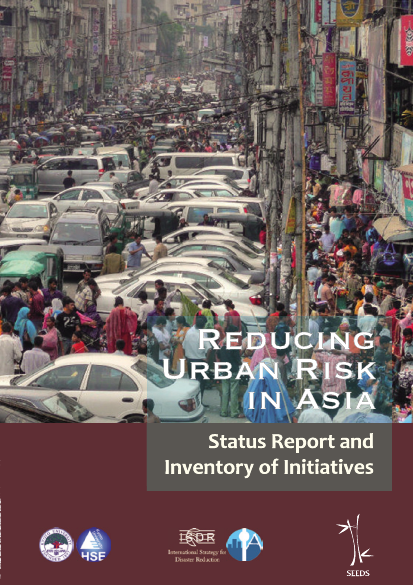
The pace of urbanization in the developing world is led by Asia. Urbanization is increasingly located in the developing countries: in 1970s, 50% of urban residents lived in developing countries, whereas it is increased to 66% in 1990s, and is projected to be 80% by 2020.
The “Hyogo Framework for Action 2005-2015: Building the Resilience of Nations and Communities to Disasters” (HFA) was adopted at the World Conference on Disaster Reduction (January 2005, Kobe, Japan). The HFA specifies that disaster risk is compounded by increasing vulnerabilities related to various elements including unplanned urbanization. Across the HFA, important elements on urban risk reduction are mentioned as one of crucial areas of work to implement the HFA. In particular incorporating disaster risk reduction into urban planning is specified to reduce the underlying risk factors (Priority 4).
Recognizing that there is a growing need to address the subject area of urban risk reduction with concerted and coordinated efforts among stakeholders, in particular in Asia, the UNISDR Hyogo Office together with close partners took an initiative to develop the Asia Regional Task Force on Urban Risk Reduction (RTF-URR) as a thematic group of the ISDR system in Asia to facilitate and accelerate efforts and actions for urban risk reduction. To understand the current status and challenges in the area of urban risk reduction, RTF-URR took the initiative to compile an inventory of initiatives relevant to urban risk reduction. The inventoried cases have been categorized and analyzed on the lines of the five priorities of the Hyogo Framework for Action; 1) Making disaster risk reduction a priority, 2) Improving risk information and early warning, 3) Using knowledge and education to building a culture of safety and resilience, 4) Reducing the underlying risk factors, and 5) Strengthening preparedness for effective response.
Based on the initiative mapping exercise and analysis on urban risk issues in Asia, the Status Report and Inventory of Initiatives looks at the dimensions of urban risk with their causative factors and determinants, and at ways and means that have emerged through pilot interventions on addressing risk through innovative means such as community led disaster risk reduction initiatives.
The urban risk issue in Asia is being addressed by various institutions at different levels through regional programmes by regional entities, through national programmes by country governments, and through city level and local level activities by community level entities. The Asia region is uniquely positioned to have a synergy of activities of UN, bilateral donors, governments, and specific activities by civil society organizations and academic institutions. Urban risk reduction in Asia needs a balanced mix of policy implementation, regulatory measures and education awareness programs through community based approaches.
UNISDR is going to launch its next global DRR campaign 2010-2011 focusing on urban risk reduction. The global campaign should aim at creating an enabling environment of risk reduction in urban areas and enhancing the resilience of people and communities. The RTF-URR is committed to serve as the advocacy vehicle to advance the concerted efforts to address the challenges in urban risk reduction in Asia.
Resource collections
- UN Habitat - Urban Response Collection
- Urban Response - Urban Crisis Preparedness and Risk Reduction
- Urban Response Collection - Community Engagement and Social Cohesion
- Urban Response Collection - Economic Recovery
- Urban Response Collection - Environment and Climate Change
- Urban Response Collection - Housing, Land and Property
- Urban Response Collection - Urban Crisis Response, Recovery and Reconstruction
- Urban Response Collection - Urban Resilience